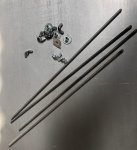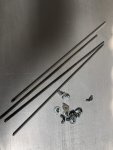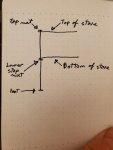So I just came into a SO U-turn stove for my floorless... I'm less than impressed with the legs:
- cheap steel threaded rod
- hardware store fasteners: wing nuts... really?
- all heavy and janky
My biggest issue is having not having fixed stops on the threaded rod based on the stove height which doesn't change. This seems like a no-brainer. I get that this will allow for crazy deep adjustment to foot height for leveling but I have several stoves with no adjustment and I make them work fine with shimming in the field. This set-up also seems overly heavy.
Here's what I'm trying:
- Change to 3/16 OD x 8.5" ti rod, threaded 10-24 on both ends: faster install, lighter weight
- Make 5" Aluminum tube feet threaded for 10-24 to tension bottom: lighter weight, faster install
- install low profile rivet nuts (10-24) to stove top: Enables totally flat top for cooking, less parts to lose
So with this new set-up, the threaded rod would still tension the stove bottom to top but would be fastened to rivet nuts in the top (vs. wing nuts) and threaded tube feet on the bottom for ground clearance.
Questions:
- Aluminum has a much lower melt temp than steel or Ti but it also has excellent conduction. I think it should be able to shed heat fine for the feet but we will see! Ti- tube is way too expensive in this application for me.
Here's the part list:
Ti Rods: https://www.mcmaster.com/89145K12/
Alum feet: https://www.mcmaster.com/1658T32/
Rivet nuts: https://www.mcmaster.com/98560A551/
I'll post up pics once I do this but meanwhile any ideas you all have for doing this differently I'm all ears!

Here’s where it stands today: 16 loose parts and 5.7 oz (161 grams).
- cheap steel threaded rod
- hardware store fasteners: wing nuts... really?
- all heavy and janky
My biggest issue is having not having fixed stops on the threaded rod based on the stove height which doesn't change. This seems like a no-brainer. I get that this will allow for crazy deep adjustment to foot height for leveling but I have several stoves with no adjustment and I make them work fine with shimming in the field. This set-up also seems overly heavy.
Here's what I'm trying:
- Change to 3/16 OD x 8.5" ti rod, threaded 10-24 on both ends: faster install, lighter weight
- Make 5" Aluminum tube feet threaded for 10-24 to tension bottom: lighter weight, faster install
- install low profile rivet nuts (10-24) to stove top: Enables totally flat top for cooking, less parts to lose
So with this new set-up, the threaded rod would still tension the stove bottom to top but would be fastened to rivet nuts in the top (vs. wing nuts) and threaded tube feet on the bottom for ground clearance.
Questions:
- Aluminum has a much lower melt temp than steel or Ti but it also has excellent conduction. I think it should be able to shed heat fine for the feet but we will see! Ti- tube is way too expensive in this application for me.
Here's the part list:
Ti Rods: https://www.mcmaster.com/89145K12/
Alum feet: https://www.mcmaster.com/1658T32/
Rivet nuts: https://www.mcmaster.com/98560A551/
I'll post up pics once I do this but meanwhile any ideas you all have for doing this differently I'm all ears!

Here’s where it stands today: 16 loose parts and 5.7 oz (161 grams).
Attachments
Last edited:


